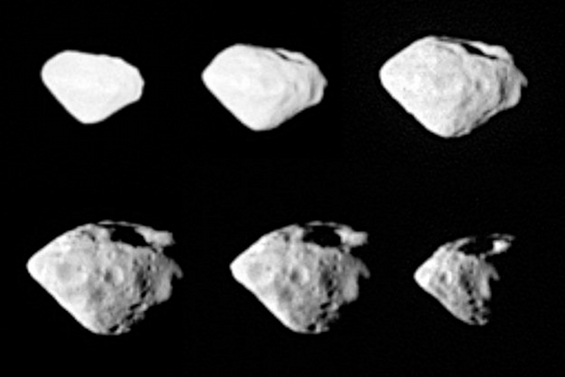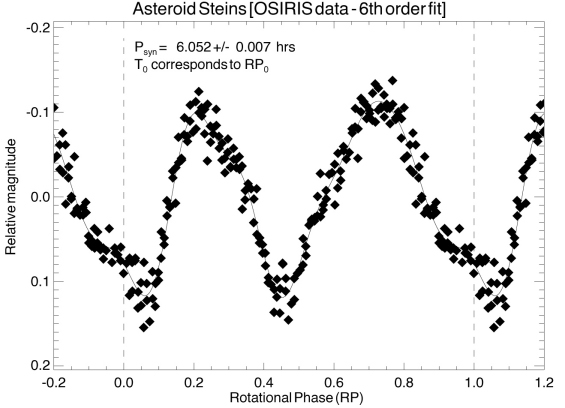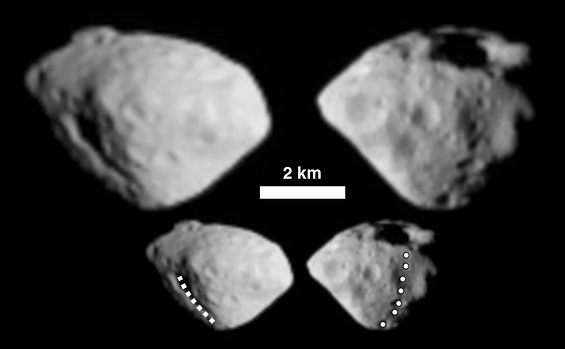Asteroid (2867) Steins
 |
| Images of asteroid (2867) Steins taken by the OSIRIS Wide Angle Camera on Rosetta during the fly-by of 5 September 2008. Credit: ESA ©2008 MPS for OSIRIS Team MPS/UPD/LAM/IAA/RSSD/INTA/UPM/DASP/IDA |
Preparing for fly-by
In preparation for the flyby, observations of asteroid Steins were performed using Rosetta’s OSIRIS camera in March 2006. Continuous coverage of the asteroid, lasting more than 24 hours was obtained at a phase angle of 41.7 degrees – this is larger than the maximum phase angle of Steins (30 degrees) that can be seen from Earth. Several hundred images covering four rotation periods without interruption, were acquired.
 |
| Light curve of asteroid (2867) Steins from OSIRIS data, March 2006. Credit: from Küppers et al., 2007 |
Analysis of the data revealed that the light curve of asteroid 2867 Steins is double peaked with an amplitude of approximately 0.23 mag. The rotation period was determined to be 6.052 ± 0.007 hours which confirmed previous measurements obtained from ground. The continuous observations over four rotation periods excluded the possibility of period ambiguities. The asymmetry of the light curve implied an irregular shaped asteroid.
Rosetta imaged Steins regularly with its cameras from about one month before closest approach, allowing more precise calculations of the asteroid’s orbit. This was essential because the orbit was not well enough known based on observations from the ground to allow for a close fly-by.
Closest approach
| Asteroid Steins as viewed by OSIRIS (wide-angle camera) onboard Rosetta during the flyby of 5 September 2008. Credit: ESA ©2008 MPS for OSIRIS Team MPS/UPD/LAM/IAA (Click here for further details and larger versions of this video) |
The closest approach took place at 20:58 CEST ground time, 20:38 CEST spacecraft time, on 5 September 2008. Rosetta was at a distance of 800 km with a relative speed with respect to Steins of 8.6 km/s, or about 31 000 km/h.
To get the best science return from the flyby, the spacecraft had to be manouevred to the limits of its design, including flipping over and changing its orientation rapidly. This required a break in communications with Earth. In its asteroid fly-by mode, Rosetta’s orientation was automatically controlled by the on-board navigation cameras. The asteroid was tracked continuously and kept it in the field of view of the imaging instruments.
Steins was shown to be a diamond-shaped asteroid, with dozens of visible craters. The images showed a gaping hole at the south pole of Steins – a large impact crater about 2 km wide and nearly 300 m deep. A chain of several craters runs towards the north pole from this crater, which was given the name "Diamond". Another large crater in the centre of the asteroid is about 650 m wide and 80 m deep and was named "Topaz".
Science results
The observations by OSIRIS and VIRTIS on Rosetta brought new information that could not have been gained from the ground. The dimensions of Steins were found to be 6.67 × 5.81 × 4.47 km3. Rosetta scientists believe that Steins was part of a larger differentiated object that had broken up. It was later struck by other objects, creating impact craters. However, the interior is thought to be a rubble pile and the asteroid will eventually break up.
In their paper E-type asteroid (2867) Steins as Imaged by OSIRIS on board Rosetta, H. Uwe Keller and colleagues conclude that Steins probably gained its diamond shape from the YORP effect - the Yarkovsky-O'Keefe-Radzievskii-Paddack effect – in which photons from the Sun are re-radiated as infrared emission taking momentum from the body and altering the rotation rate. In this case, the change in rotation rate resulted in some material moving towards the equator of the asteroid.
Keller et al also attribute surface reshaping to the YORP effect, accounting for the lack of smaller craters on Steins. The effect would have caused landslides to fill in the smaller craters. This is the first time that the YORP effect has been seen in a main-belt asteroid.
The features visible in the images obtained near closest approach give further clues about the asteroid’s history and future. The Diamond crater, and the chain of pits that extend northwards, suggest that Steins was subjected to a big impact, which created the large crater and caused fracturing of the asteroid body resulting in it having a rubble pile structure. This type of loosely bound structure is also consistent with the YORP effect hypothesis. The structure suggests that Steins will eventually fall apart.

